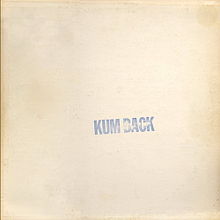Kum Back
| Kum Back | |
|---|---|
 |
|
| Studio album (bootleg) by The Beatles | |
| Released | September 1969 |
| Recorded | January 1969 |
| Genre | Rock, folk rock, blues |
| Length | 38:33 |
| Label | Trademark Of Quality |
| Producer | Unknown |
Kum Back is the first bootleg album by The Beatles, released in September 1969. The album is an early mix of what would become 1970's Let It Be, taken from an acetate prepared by the group's producer, Glyn Johns. It is one of the earliest commercial rock bootlegs, the first being Bob Dylan's Great White Wonder, which was released in July of the same year.
All tracks on Kum Back were recorded during the Get Back/Let It Be Sessions of January 1969, and all were recorded in the basement studio of 3 Savile Row, London, England. "I've Got a Feeling," track seven, was recorded on 24 January 1969 and is probably the earliest recording on this album.
The first appearance of a vinyl copy of the recordings appeared on the black market sometime in January 1970. Many conventional record stores also began to carry the album that same year.
The cover of the album is a plain white sleeve as issued by the pressing plant, with a blue or red rubber-stamped "KUM BACK" in all capital letters, on most copies slightly crooked (tilted to the left) slightly below center and to the right, apparently added by the agents who issued the album. On some copies the title is not completely legible due to the speed or carelessness in applying the rubber stamp to the finished sleeves. Similarly, the record labels are plain white, with no artist or title. The only indication as to which is Side One and Side Two is scratched into the space of the play-out grooves on either side, very likely done at the master, mother, or stamper phase of the pressing. It is most likely that the listing for artist and titles were omitted by the agents who prepared the recording to avoid the pressing being rejected by the pressing plant, and to avoid legal action.
Glyn Johns prepared an early mix of what would eventually become Let It Be around 28 January 1969. It was probably used for reference when the actual mixing was undertaken. Several other acetates seem to have been pressed at the time, and in the actual Let It Be film, as Ringo Starr shows George Martin his new song Octopus Garden, Paul McCartney can be heard asking Starr what he thought of the "Dubs" from the previous night - Dubs being another name for reference acetate. It has also been rumoured that John Lennon had taken one of these pressings to America during a 1969 visit, then traded it for several unreleased recordings he did not own. Lennon later spoke about the record: "They say it came from an acetate that I gave to someone who then went and broadcast it as being an advance pressing or something." Apart from this quotation, the original story is very hard to verify.
...
Wikipedia
